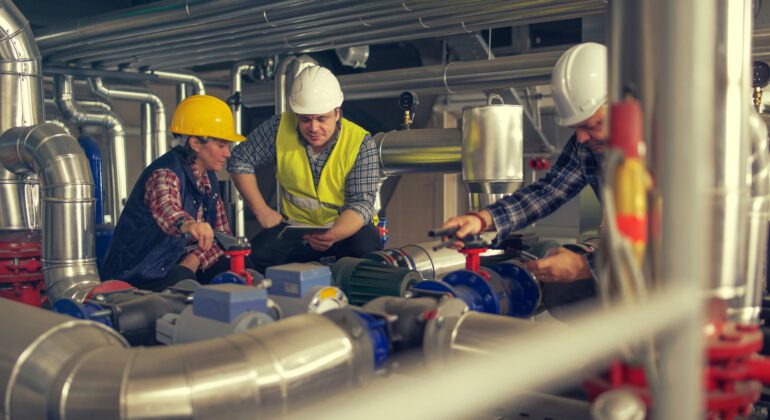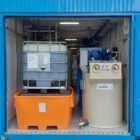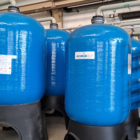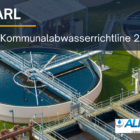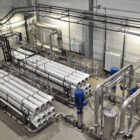The maintenance and repair of wastewater treatment plants are crucial for smooth and effective uptime. A faulty system can lead to non-compliance with the applicable limits. To ensure that a wastewater treatment plant is operated safely and effectively, all components must be regularly maintained and repaired.
In this blog article, we will discuss the most important steps for effective maintenance and repair of wastewater treatment plants.
Table of contents
Why is regular maintenance and repair important for a wastewater treatment plant?
A wastewater treatment plant is a complex system for protecting our waters and environment. It is therefore of great importance that such a system is operated in perfect condition. Regular maintenance is the key to ensuring smooth uptime and avoiding costly system failures.
During the operation of a wastewater treatment plant, pumps, aeration systems, reaction tanks, measuring technology and sedimentation tanks are subjected to heavy loads. This can lead to wear and tear, which affects the performance and efficiency of the plant. Regular maintenance allows signs of wear to be detected and rectified at an early stage before serious problems occur.
Carefully planned maintenance can also help to improve the energy efficiency of the system. Proper maintenance of pumps and ventilation systems can reduce energy consumption and lower operating costs. In addition, regular maintenance can also help to extend the life of the system and thus protect the company's investment.
Repairs should also not be neglected. If a part of the system fails, this can lead to a standstill, which can result in an undesirable delay in production and possibly environmental damage. Fast and professional repairs can minimize downtime and reduce operating costs.
Maintenance planning: How often should maintenance be carried out and what steps should be taken into account?
Regular maintenance is essential to ensure the optimum performance and efficiency of a wastewater treatment plant. But how often should maintenance be carried out and what steps should be taken into account?
The frequency of maintenance depends on various factors, such as the size of the system, the type of technology used and the environment in which the system is operated. In general, it is recommended that maintenance is carried out every 6 to 12 months. In some cases, more frequent maintenance may be necessary, especially if the system is subject to heavy use or is older.
Inspection and maintenance of pumps: Why are pumps the heart of a wastewater treatment plant and which steps are important during inspection and maintenance?
In industrial wastewater treatment, pumps are at the heart of every system. They ensure that the wastewater is transported through the various treatment stages, thus enabling the effective treatment and removal of pollutants. For this reason, it is important that the pumps are regularly inspected and maintained.
The inspection of pumps includes a visual check and a performance check. The pumps are checked for possible damage, wear and blockages. It is also important to check the pressure and flow values as well as the power consumption to ensure that the pumps are working optimally.
Maintenance measures should also be carried out regularly in order to extend the service life of the pumps and minimize downtimes. This includes cleaning filters and pump bodies as well as replacing wearing parts such as seals, slide rings or bearings.
Professional maintenance and inspection of pumps is not only important for the reliable functioning of the wastewater treatment plant, but also for environmental protection. Optimum pump function ensures effective protection against harmful substances and thus minimizes the risk of environmental damage.
Inspection and maintenance of aeration systems: How do aeration systems ensure an optimal oxygen supply in the wastewater treatment plant and what steps are important during inspection and maintenance?
Aeration systems are an essential component of aerobic wastewater treatment plants. They ensure that the bacteria in the wastewater are supplied with sufficient oxygen to enable effective purification of the wastewater. For this reason, it is important that the aeration systems are regularly inspected and maintained.
The inspection of aeration systems includes a check of the air supply, the membranes and the pressure loss. Here, attention is paid to whether the aeration systems are working optimally and whether repairs or replacements are necessary.
Maintenance measures should also be carried out regularly to extend the service life of the aeration systems and minimize downtimes. This includes the cleaning of membranes and pipes as well as the replacement of wearing parts such as air filters or membranes.
Inspection and maintenance of clarifiers and sedimentation tanks: How are clarifiers and sedimentation tanks cleaned and what steps should be followed during inspection and maintenance?
Clarifiers and sedimentation tanks are important components in a wastewater treatment plant. They are used to clean wastewater and remove pollutants before it is discharged into the environment. To ensure effective wastewater treatment, it is important that the clarifiers and sedimentation tanks are regularly inspected and maintained.
During the inspection of the clarifiers and sedimentation tanks, the tanks are checked for cracks, leaks and other damage. The function of the drainage and aeration systems is also checked to ensure that they are working properly. Thorough cleaning is also important to remove deposits and dirt from the basins and increase the efficiency of wastewater treatment.
Maintenance measures include the repair or replacement of damaged parts, such as pipes or pumps. Cleaning the drainage and aeration systems and checking the water quality are also important steps that should be taken into account when maintaining clarifiers and sedimentation tanks.
Regular inspection and maintenance of clarifiers and sedimentation tanks can help to extend their service life, minimize downtime and increase the efficiency of wastewater treatment. It can also help to minimize potential environmental damage.
Repairs: How do you recognize when repairs are necessary and what steps should be taken?
Repairs are an important part of industrial wastewater treatment to ensure that the system operates effectively and safely. There are various signs that may indicate that repairs are necessary. For example, unusual noises or vibrations from machinery can indicate a problem. A sudden drop in efficiency or water quality can also be a sign of a problem.
As soon as a problem has been identified, it is important to act immediately. A delay in repair can lead to further damage to the system and ultimately to a breakdown of the entire plant. Therefore, companies involved in industrial wastewater treatment should carry out regular inspection and maintenance to identify and rectify problems at an early stage.
Various steps should be taken into account when carrying out repairs. First, an accurate diagnosis of the problem should be made to ensure that the correct steps are taken. Then the necessary spare parts should be obtained and the repair carried out. A thorough inspection of the system after the repair is also important to ensure that the problem has been fully resolved.
Conclusion
An effective and safe wastewater treatment plant is crucial for protecting our environment and complying with legal regulations. Therefore, companies operating a wastewater treatment plant should ensure that their plant is running smoothly and that problems are identified and rectified at an early stage.
Regular inspection and maintenance of the system is the key to effective and safe uptime. This includes the inspection and maintenance of pumps, aeration systems, clarifiers and sedimentation tanks as well as carrying out repairs as required.
It is also important to ensure that the plant is operated with the correct treatment equipment to ensure optimum performance and safety. Employees should have appropriate training to ensure that they are able to operate the plant effectively and identify problems at an early stage.
If you need assistance with the inspection, maintenance and repair of your wastewater treatment plant, please contact us. Our experienced team can help you maintain your plant and ensure effective and safe uptime.
If you would like to know more about our individual operational management packages, please contact us or read more details under the following link: Operations Management.


